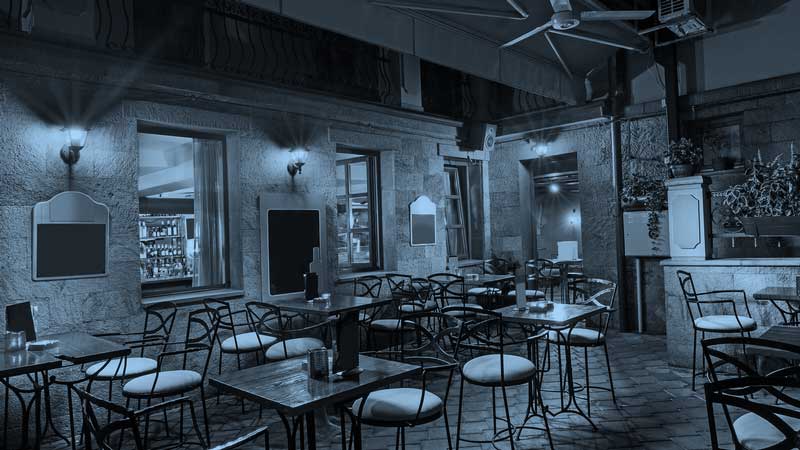Blog
Return to Blog »
Janis Kent, FAIA CASp © May, 2015 When we do layouts of tables and seating, the question comes up – how much space between the tables and aisles are we going to need? We know we are required to have 5% of the seating accessible and dispersed within the area, but there is nothing specific on spacing other than that the tables are accessible and require a specific amount of clear floor space and the aisles require a specific width. So, we need to put this information together. Disregarding any requirements for exiting purposes, the ADA Standards require a 36″ minimum clear aisle to be accessible. California requires 36″ if the aisle is single loaded and 44″ if it is double loaded. Per ADA, seating can not be located within this clear width. And as a note, we are only required to have an accessible route to accessible seating – not all of the tables. Seating Backed Up to an Aisle Seating Backed Up to a Wall or Other Obstruction Since the table itself is typically deeper than 24″ from the aisle towards the back wall it would in essence be creating an alcove. For side approach, the clear floor space would be a space of 60″ wide by 30″ deep. It would require the full 60″ length to be contiguous to the circulation aisle itself – so you could not use the knee/toe space under the table for maneuvering. Another option, you could use a front approach of 36″ wide and provide a ‘T’-shaped maneuvering space (60″ x 60″ with two 12″ x 24″ notches). The table would need to be 48″ minimum from the aisle side towards the back wall with the extra 12″ of maneuvering space located within the aisle leading to the seating. The bottom leg of the ‘T’ would be under the table. So with the first option, you would need 60″ clear from the table edge to the wall/obstruction with a minimum of 30″ clear depth to the back wall. With the second option the 60″ could be reduced to 36 ” but a minimum clear depth of 48″ would be required. Do note that these previous options would only allow for one person to sit on this side of the table and the table depth from the aisle edge to the back wall would need to be increased to get another seat adjacent to and outside of the maneuvering space. Approach Remember that the accessible seating space requires one full side to be adjacent to an accessible route or another clear floor space and that more room may be required for maneuvering depending on whether the seating area is in an alcove or has an obstruction to the back of the chair space, or if there is a leg under the table preventing a side approach. And generally this applies to fixed furniture, but if the tables are not fixed, you would still need to provide accessible seating. In my opinion, when planning a space, I would use this same criteria whether or not the tables are fixed. And do remember that all of these dimensions are minimum! Thanks to Jerome S., Amir H., Rich M., and Alan D for the topic request. If you have a topic you’d like to request, please email me. Be aware that your local City or County may have additional requirements that are more restrictive than the State or Federal requirements. Also, this article is an interpretation and opinion of the writer. It is meant as a summary – current original regulations should always be reviewed when making any decisions. © Janis Kent, Architect, FAIA, CASp 2015 Restaurant, Bar, Banquet, Desk, and Cafeteria Seating – How much space do we need?

So how much space is required for the seat itself? We know that a wheelchair space takes up 30″ x 48″ if it is not in an alcove. Tables and counters require a minimum of 17″ knee/toe clearance below up to a maximum of 25″. Presuming the minimum dimension of 17″, the wheelchair would stick out 31″ from the edge of the table/counter. So if the table/counter backs up to an aisle we know the table edge should be inset 31″ minimum from the required aisle width (31″ + 17″ = 48″ for the clear floor space). California requires a minimum of 2″ more under the table/counter – 19″ which means you need only 29″ clear to the aisle rather than 31″.
This is fine for seating backing up to an aisle, but what happens if the seat backs up to a wall or some other obstruction? Presuming that the table has a leg in the outer corner, there are several things to keep in mind. And do, note, that a table with a pedestal, can not have the pedestal base within the clear floor or maneuvering space.
Another situation to consider would be the approach to the table itself and if it requires a ‘U’-turn from the aisle to get positioned at the table. If the aisle leading to the table is less than 42″ wide, then you would be required to have 60″ from table edge to the wall/obstruction. If the aisle leading to the table is 42″ or more then only 48″ deep would be required for the ‘U’-turn. These dimensions would need to be superimposed on the preceding and whichever requires more space would need to be applied.